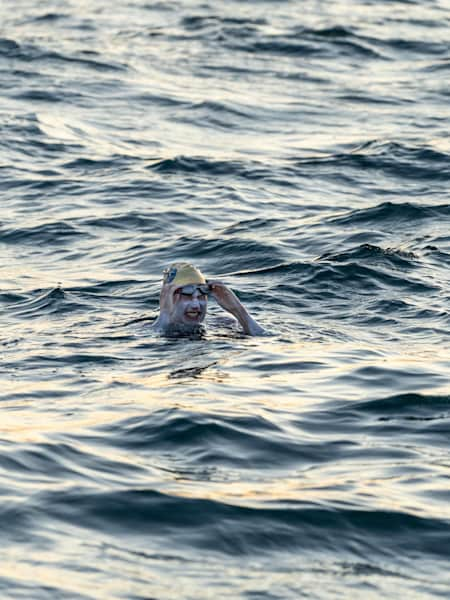There are tests of endurance that make the public sit up and take notice, then there are challenges that push the limits of human suffering into new, unchartered territory and make people reassess just what is possible for humans to achieve.
Sarah Thomas did that when she swam the English Channel four times in a row non-stop, in September 2019.
Smashing the previous record of three crossings non-stop, the 37-year-old swimmer from Colorado battled prolonged sickness on her 54-hour, 130-mile swim, which should have been around 80 miles but was made considerably longer thanks to punishing tides.
Not only that, prior to her swim, Sarah was diagnosed with breast cancer. Her treatment ended just 12 months beforehand, and the swimmer used this challenge as a focus to help her get through the multiple rounds of chemotherapy, surgery and radiotherapy.
Her astonishing achievement is unlikely to be beaten by anyone any time soon – here are the many ways it’s inspiring to all of us. Listen to Sarah's story on season two of How to be Superhuman podcast here.
1. She dedicated her swim to cancer survivors
In November 2017, within a few months of deciding to attempt four crossings, Sarah was diagnosed with breast cancer.
“It was one of those moments where you think, ‘Is this happening to me? I’ve got big swims on my radar and now I have cancer?’ says Sarah. “I did 20 rounds of chemotherapy, then had surgery to remove the tumours, then ended with 25 rounds of radiation, which finished in September 2018.”
Sarah continued to swim during her treatment – her doctors believe that because she was swimming it helped her battle some of the side effects of the chemotherapy. “From a mental perspective, it was a huge help,” says Sarah. “Swimming gave me a place to be free and to forget about what I was going through. It provided peace among all the crazy and terrible things [that were] happening."
In May 2018 she was given the all clear, and from then she dedicated herself to the Channel. “The doctors knew I was looking at doing it in September 2019, and that was an important date in the future. I actually delayed some of my reconstruction surgery so that I could train for this swim, so I still have to undergo more surgery.”
2. She broke the record by one complete crossing
Sarah first swam the English Channel in 2012. “Back then I was still pretty new to open water swimming,” she says. “The Channel was just one of those iconic swims that everybody knows about, and I signed up thinking, ‘That might be fun.’
“It was beautiful – a magic swim. And when I was standing on the French shore at the end I thought, ‘I probably could swim back right now.’”
It wasn’t until Sarah was crewing for a friend’s English Channel swim in 2016 – just before she took on her own first 80-mile swim – that she seriously thought about doing more than one crossing of the Channel. “I started to look into it and discovered that people had done it three times, but no one had done it four. I did well in my 80-mile swim and thought, ‘You know what? I could do it four times.’”
3. She fit her training in around a full-time job
Sarah works full-time in the US as a health care recruiter, so crowbarring enough long distance swimming in around her job is a challenge. “I’m great at scheduling,” she says. “I follow a weekly routine and that way I can just about get everything done. When I’m training hard I usually swim twice a day three times a week, after work the other days, then do long swims on the weekend.”
She also coaches herself. “I had to start off with small weekly goals on this training block as I was recovering from treatment, and then build up. I maxed out this cycle at around 100km a week.”
4. During the swim, she was almost immediately stung on the face by a jellyfish
In a Ross Edgley-esque challenge, there has to be a fittingly Ross Edgely-esque problem to overcome. And lo and behold, it was UK-based jellyfish, who took a shine to Sarah soon after she had left Dover. “I got stung on my face,” she says. “I took one square on the chin. It happened early on, so by the time I finished it was fine.”
5. She was VERY sick...
And it wasn’t caused by seasickness or the saltwater… “I jumped in the water at midnight and almost immediately felt nauseous,” says Sarah. “I’d eaten something earlier in the day that wasn’t sitting well. The sun came up around 6am and I finally threw up whatever I’d eaten that was bad. Then a couple of hours into lap two I started throwing up again. I was having a lot of acid reflux and was not feeling well at all."
6. ...which meant she barely ate any solids
“I was only taking on liquids. I ate a bit of rice at the first turnaround. I realised I’d been drinking a lot of apple juice, and I thought perhaps that was what was making me sick, so I told my crew, ‘No more apple juice.’ After that, I started to feel better, got some calories into me, and by the time the sun came up I felt pretty decent considering I’d been throwing up for quite a long time at that point.”
7. She nearly quit after two crossings
Following two complete crossings, Sarah hit a huge low point. “When we did the turn in Dover I tried to eat some baby food and I threw that up,” says Sarah. “I was really demoralised and was close to quitting. I thought, ‘Two laps is plenty, who cares?’ But my crew re-motivated me. They didn’t let me dwell on any negatives. If I said, ‘I feel sick’, they said, ‘You’ll be all right, it’s not a big deal, just keep swimming.’ I threw up all over my friend Karl, and he was like, ‘It’s OK, just let it out, you’ll feel better once you’re done.’”
8. She did it in a swimsuit
The Channel-crossing rules set by the Channel Swimming & Piloting Federations state: ‘No swimmer in a standard attempt to swim the Channel shall be permitted to use or wear any device or swimsuit that may aid his/her speed, buoyancy, heat retention or endurance (such as a wetsuit, webbed gloves, paddles, fins, etc.).’ For Sarah, luckily, this was not a problem. “I don’t own a wetsuit – I’ve never even put one on! But the water temperature was generally OK. When I was sick, I felt cold, but when I was swimming along fine it was not a problem.”
9. She did not sleep for 54 hours
Sarah finished the swim 54 hours after starting – that’s two-and-a-quarter days of continuous swimming without any sleep. “It’s hard to deal with the lack of sleep,” she says. “Because of the tides and the weather, we had to start at midnight, which is not the ideal time from a sleep-deprivation perspective. But I knew that, mentally, I’m pretty good at pushing through lack of sleep. I use electrolyte tablets with caffeine in, so when I start to feel drowsy, a tiny bit of caffeine helps.”
10. She struggled to get into ‘the flow’
Many endurance athletes talk about their quest for ‘the flow’ – the state of being during feats of physical endurance when your mind empties and time vanishes. But due to the bouts of sickness, Sarah found it hard to enter this state that normally helps her get through challenges such as this. “That was one thing that made this swim so much harder – I couldn’t get to that empty place that I normally do. I prefer to enter a state where my mind is blank. During the second night, when I was miserable, I kept saying, ‘I can swim through this night’ over and over just to motivate me, which is something I’ve never done before.”
11. She had to sprint to beat the currents
“We’d made the final turn in France, and I thought everything was going to be easy from there,” says Sarah. “Then we hit some weird currents. I’d done 11/12-hour laps on the previous three crossings, and the final one took me 17 hours, as the currents were pushing me all over. There were a couple of times where I had to sprint hard to break through a current. I was tired, had been puking and it was tough to swim as fast as I could. But my crew did a good job of cheering for me and encouraging me, and I made it to the beach for the last time.”
12. She believes anyone can do it
“I know that I’m not the best swimmer out there,” says Sarah. “There are plenty of people far more gifted than I am. I just really wanted it, and that’s the biggest piece of it. People can do a lot of things, as long as they believe in themselves. If you believe in yourself and put your mind to it you can basically do anything. You just have to want it hard enough.”
13. She thinks she could do five crossings
This may not be the last we see of Sarah Thomas in the Channel… “I think if I had not been so sick, I could have definitely have done a fifth lap. From a time perspective, definitely…”












